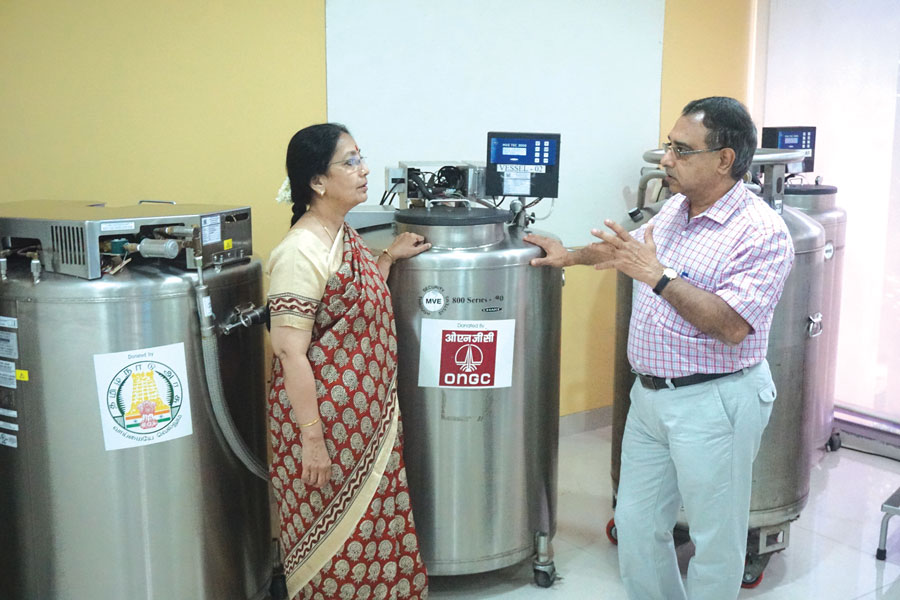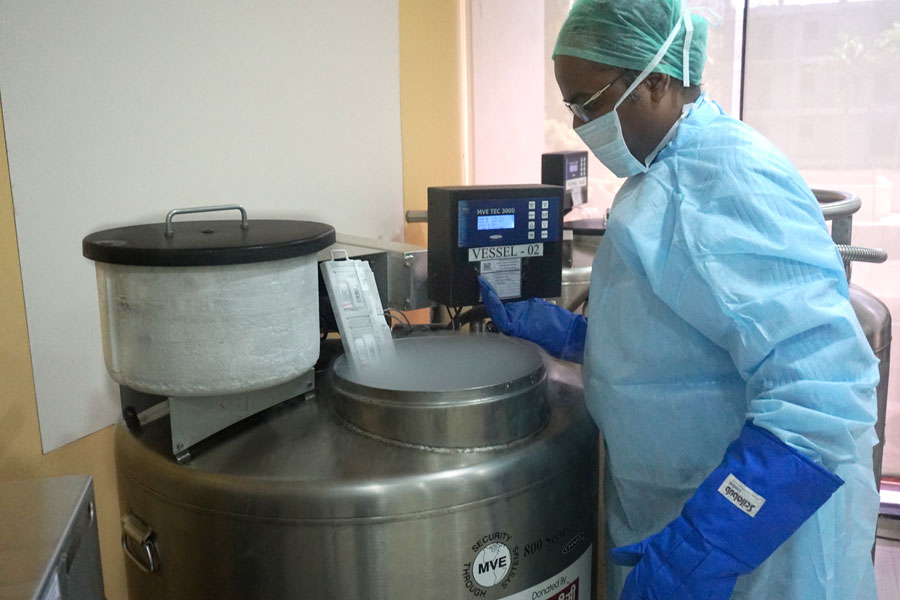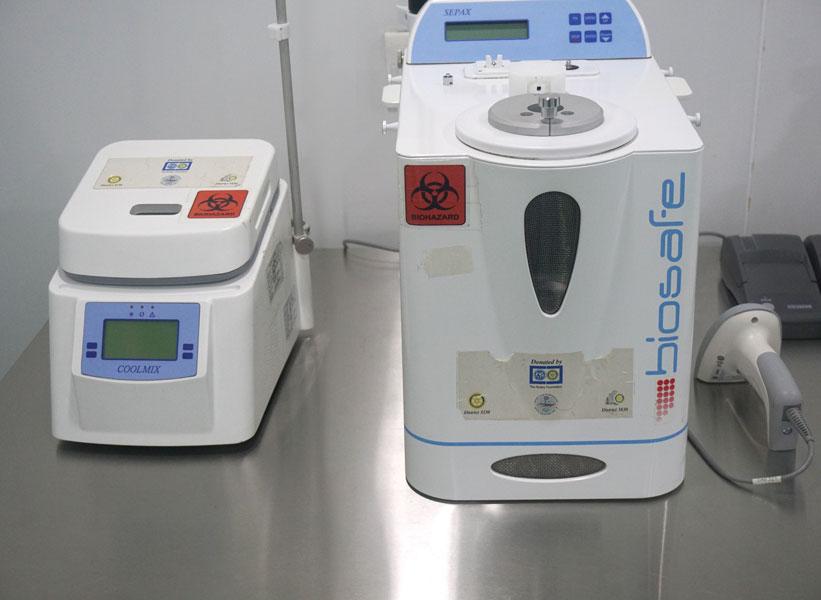The cells that save lives Two doctors in Chennai are waging a battle to grow a public cord blood bank to the level it can effectively save more and mitigate the trauma of blood cancer, thalassaemia and other patients.

Every year 24 million babies are born in India and along with the placenta and the umbilical cord that is disposed as biological waste, precious stem cells and cord blood which can save lives of many Indians suffering from blood disorders such as blood cancer, thalassaemia and some inherited metabolic disorders, are discarded.
India has made amazing progress in medical technology and our relatively low costs of state-of-the-art medical treatment gets us patients from even developed countries. But stem cell transplantation has not taken off, because we do not have a public stem cell bank, and this facility is hitherto limited only to private cord blood banks, where rich individuals pay tens of thousands of rupees to store the baby’s cord blood in the hope it can be later used either for the same child, the siblings, parents, or other relatives.
About 120,000 Indians are diagnosed with blood cancer, and one third of these are children. And 10,000–14,000 children are born and diagnosed with thalassaemia.
But Dr P Srinivasan, a Chennai-based crusader and once a Rotarian, — “now on a sabbatical from Rotary”, — , has been waging a long battle to establish a sizable public stem cell bank in Chennai “which will benefit Indian children globally.”
He points out that China has such a blood bank with a whopping 150,000 units, Singapore with 12,342 units, Australia and even SE Asian countries such as Thailand and Malaysia have decent cord blood banks. Over 50,000 cord blood transplants have been done in the world, with every year 2,000 more being added. But in India among the 250-odd transplants being done, mostly very few are cord blood stem cells because there is no large public bank.

He set up the Jeevan Blood Bank as a public charitable trust in Chennai along with Dr Saranya Narayan in 1995. “In 2005, when we were 10 years old and supporting many children with free blood for thalassaemia management — they need blood transfusion every month to survive — we also had a few patients with blood cancer requiring regular blood transfusion post chemotherapy, and a parent asked us about possible cure with stem cell transplantation.”
At that time global discussions were happening on stem cells from cord blood, and Jeevan got interested as Indian children were dying from ailments which could be treated using cord blood as in the west and that too 1985 onwards,” he says.
Cord blood
Once the baby is born and the umbilical cord is cut, the placenta and the cord, containing precious blood cells, is dumped into the waste bin. That blood contains enough stem cells to cure children with blood disorders, with a success rate of 60–80 per cent. Jeevan already had the expertise to process the blood it receives from voluntary blood donors. “We spin it in the centrifuge, separate the blood components, store them at different temperatures and give to patients. The tests we run for HIV, Hepatitis B, etc would be the same for the cord blood. The major difference is that the stem cells have to be stored at minus 185 deg C.” For harvesting stem cells to international standards, automated machines would be required.
For a donor and recipient to match for stem cell transplant, their Human Leucocyte Antigen (HLA) have to match. This is DNA match and is on the white cells, and that DNA is highly ethnicity dependent.

“For example, if I am A positive and go to Spain and need blood in an emergency, it is pretty easy to get and it works. But the stem cells don’t work the same way, being highly ethnicity dependent, so the chances of finding a match are much higher in your own ethnic pool,” says Dr Srinivasan, who is Chairman of Jeevan.
He gives the example of Prof Nalini Ambady, an Indian from Tufts University, US, who battled leukemia for many years but finally succumbed in 2011 at the age of 54, when her family’s desperate search for a matching and willing bone marrow donor failed, as there were few Indians on these registries.
Realising they had both the experience and expertise, they decided they should do much more with the blood bank than serve just 10,000 people in Chennai. “So we grabbed the chance in 2007 to touch Indians globally and set up a much needed public cord blood bank,” says Dr Saranya, who is Medical Director of Jeevan.
SAARC countries should work together to establish a public cord blood bank. They have to look beyond playing cricket.
Just as in blood transfusion, stem cells or bone marrow need to be taken from healthy normal donors. “And if the DNA matches, it can create magic,” says Dr Srinivasan. According to recently released statistics, 120,000 Indians are diagnosed with blood cancer, and one third of these are children. And annually, 10,000–14,000 children are born and diagnosed with thalassaemia. Many of these children can be helped by stem cells transplant.
On why Jeevan would like to concentrate only on children, the reply is that the number of stem cells in a single unit of cord blood are sufficient only to treat a child upto around 30 kg of body weight. Whereas in a bone marrow donor, the cells are large so they can be used for adults. “In 2015, Jeevan started the bone marrow donor registry with seed grants from Tata Trust, United Way of Chennai, Consulate General of Australia and Sundaram Finance.”
But the advantage of cord blood stem cells, over bone marrow, is that these are readily available in a frozen format, so it takes hardly two weeks to get it to the patient’s bedside. But for bone marrow, “you have to hunt for the donor who registered probably 10 years earlier. We have to find him and then he needs to go through a process of medication after which the cells are extracted and given. A lot can happen between the cup and the lip.”
Underlining the need for India to have a strong public stem cell bank, he says that when an Indian girl needs stem cells, the chances of finding a match in the international registry with some 26 million donors, is less than 10 per cent because of her Indian ethnicity. “Even if she is lucky enough to find a match in Australia, a single unit costs $45,000, in addition to the transplant cost. Just as in the past for a coronary bypass Indians flew to the US; in the mid-1980s, coronary bypass cost Rs 20 lakh; today it costs between Rs 1 to 2 lakh. So the economy of scale operates.”
But Jeevan can provide a unit of stem cell of the same international quality at Rs 30,000, or under $500.
Work began in 2007 and by 2008 Jeevan’s cord blood bank was operational. But the sad part is that till now only five transplants have been done because it has only 5,100 stored stem cell units. “Unless we have a larger inventory, we can’t have more matches. India needs something like 30,000 to 50,000 units; then 50 to 70 per cent of children looking for a match will be able to find one. To store 50,000 units, atleast 100,000 cord blood donations are required, as only half are usually fit for processing and storage. In most cases the collected cord blood cannot be processed because of insufficient volume, or the stem cells may not be adequate for transplant,” explains Dr Saranya Narayan.
But to run and sustain such a bank is extremely difficult. “By September 2012, we had 660 units, and we were on the verge of closing down as we were minus Rs 3 crore and the newspapers wrote about it, with one saying: “Public cord blood bank is closing for want of moolah,” chuckles Dr Srinivasan.
The deadline was set for December 31, but it couldn’t find 30,000 people to donate Rs 30,000 each “because people confused us with the private cord blood banks, which is a huge industry. But then those banks are like Swiss bank lockers which only the owners can dip into!”
But suddenly, out of the blue, they got a call from the ICICI Bank offering a loan at just one per cent service charge and repayable in 2023! This was from the Technology Services Revolving Fund of GOI, and the amount on offer was Rs 15.54 crore.
And on its heels, came a grant of Rs 9 crore from the Tamil Nadu Government “to collect, process and store 3,000 cord blood collections from Tamil-speaking people and make it available free to them when needed.”
To my raised eyebrows, the doctor says, “there is nothing wrong in it. It is not racist but related to ethnicity. The HLA typing varies significantly between the different lingusitic populations of India.”
With all this money, where is the shortage, I ask him.
“Good question. With the Rs 21 crore we took up our stem cells unit count from 660 to 5,100, and also set up a facility to do high resolution HLA typing. Major registries in India were sending the DNA to the US, despite a ban on sending out human DNA, as it couldn’t be done here. We have filled that gap; coming from a background of diagnostics and pathology we felt we should do that. We spent Rs 2.5 crore to set up a high-end facility, which is now offered to patients from across India on a cost recovery basis.”
On the process of collection, he says the Obstetrician gets the parents’ consent; after the delivery, if there is no emergency, the cord blood is collected in a kit similar to blood donations kits, and sent to Jeevan within 24 to 36 hours.
Their first goal is to get 30,000 stem cell units; the cost of processing each is Rs 30,000, “so if 30,000 HNI Indians, or 30,000 Rotarians, donate Rs 30,000 each, which will enjoy tax exemption under 80G, a viable public stem cell bank with a critical number of units can be set up. And then we can scale it up to 50,000 units in the next 5 years. We will be creating a bio-asset, and not only for India but the entire SAARC region because of some similarity of DNA among us,” says Dr Srinivasan.
At present Jeevan gets around seven requests a week from world over because it is internationally listed.
Rotarians can help
He believes Rotarians can help Jeevan stem bank to go from 5,100 to the critical mass of 35,000 in the first phase. “After the remarkable gift of Rotary to children through its PolioPlus programme banishing polio from India, Rotarians have been asking what next. This project can touch Indian children with blood disorders globally and end a thalassaemia child’s need for repeated blood transfusions which costs the family Rs 2 lakh a year. The cure rate is 60 to 80 per cent. If 30,000 Rotarians can donate Rs 30,000 each, it can be done.”
The cost of stem cell transplant now is rather high at Rs 10 lakh, but Dr Saranya is confident as in coronary bypass, volume can drive down costs.
Dr Srinivasan says that the SAARC countries should work together to establish a public cord blood bank. “They have to look beyond playing cricket. A compelling reason is common ethnicity. Today the chance of a South Asian finding a match in the international registry is less than 10 per cent. That will go up to 40 if not 60 per cent if we have such a bank.”
About the cost, he says that Jeevan gives it free to a family with less than Rs 10 lakh annual income. For those above this income are asked to make a donation so that the programme remains financially sustainable.
Interestingly, a critical equipment in harvesting stem cells was donated through a matching grant of Rs 23 lakh when he was in Rotary (RC Madras East and a Philippines club which no longer exists).
Pictures by K Vishwanathan
A Crusade
On the Jeevan Board is Vigneshwaran, who once had blood cancer and underwent stem cells transplant with cord blood from a woman in Australia. “He was one of the lucky ones who could get a match,” says Dr Srinivasan. The treatment was not cheap; Rs 1.5 crore were required for the transplant done in Singapore. His friends and father raised the money. A Rotarian from RC Madras helped through a huge conribution. “When we met him around 2011–12, he was 26, already 5 years into transplant and healthy. His parents told us there is a purpose in his being alive today. Since you are doing something similar, tell us how he can help you. So he became the first face of the Jeevan project,” he says.
After an engineering degree in Anna University, and an MBA, he now works for TCS, and is now on an assignment in Chicago.
